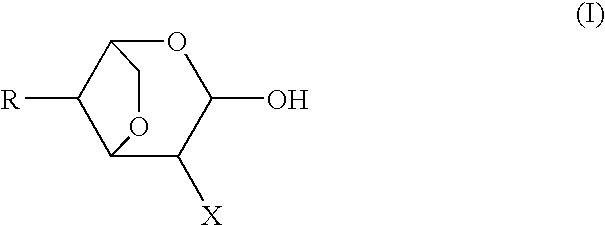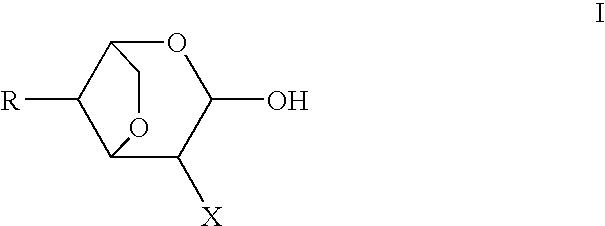Modifier
a technology of composition and modification, applied in the field of modification composition, can solve the problems of difficult to isolate a substance such as a polypeptide present in a trace amount in an organism, and achieve the effect of convenient modification
- Summary
- Abstract
- Description
- Claims
- Application Information
AI Technical Summary
Benefits of technology
Problems solved by technology
Method used
Image
Examples
example 1
[0040] (1) Commercially available agar (Ina agar type S-7, Ina Shokuhin Kogyo) was dissolved in deionized water at a concentration of 10% (w / v). A strong cation exchange resin (Diaion, Mitsubishi Chemical, SK-104) converted into hydrogen ion type was further added thereto at a concentration of 1% (w / v). After reacting at 90.degree. C. for 3 hours, the reaction mixture was cooled to normal temperature and subjected to filtration to remove the resin. The filtrate was treated with active carbon at a concentration of 2% (w / v) to remove colored substances and the like, and filtrated through a filter with pore size of 1 .mu.m. After neutralization, the filtrate was lyophilized according to a conventional method to prepare agarooligosaccharides.
[0041] The agarooligosaccharides contained water (2.3%), galactose (9.8%), agarobiose (44.1%) as well as agarotetraose, agarohexaose, agarooctaose and the like (43.4%). The pH of an aqueous solution containing the agarooligosaccharides at a concentr...
example 2
[0050] A solution containing the agarooligosaccharides as described in Example 1-(1) at a concentration of 100 mg / ml and a solution containing bovine serum albumin (Sigma, A0281) at a concentration of 11.1 mg / ml in PBS (pH 7.2) were mixed at a ratio of 1:9. The mixture was reacted at 37.degree. C. for 24 hours to obtain a modification product of bovine serum albumin.
[0051] Similarly, a solution containing the agarooligosaccharides as described in Example 1-(1) at a concentration of 100 mg / ml and a solution containing human immunoglobulin G (Oriental Yeast, IgM-04) at a concentration of 11.1 mg / ml in PBS were mixed at a ratio of 1:9. The mixture was reacted at 37.degree. C. for 24 hours to obtain a modification product of human immunoglobulin G.
[0052] The modification products of bovine serum albumin and human immunoglobulin G were subjected to electrophoresis on SDS-polyacrylamide gel together with unmodified counterparts. Shifts to higher molecular weights as compared with the unmo...
example 3
[0061] The modification products of bovine serum albumin and human immunoglobulin G separated using HPLC as described in Example 2 were adequately dialyzed against water and lyophilized. The lyophilized modification products and lyophilized unmodified counterparts for both of the proteins were similarly dissolved in water or PBS. The solubility of the modification products in each solvent was superior to that of the unmodified counterparts.
PUM
| Property | Measurement | Unit |
|---|---|---|
| Time | aaaaa | aaaaa |
| Time | aaaaa | aaaaa |
| Angle | aaaaa | aaaaa |
Abstract
Description
Claims
Application Information
 Login to View More
Login to View More - R&D
- Intellectual Property
- Life Sciences
- Materials
- Tech Scout
- Unparalleled Data Quality
- Higher Quality Content
- 60% Fewer Hallucinations
Browse by: Latest US Patents, China's latest patents, Technical Efficacy Thesaurus, Application Domain, Technology Topic, Popular Technical Reports.
© 2025 PatSnap. All rights reserved.Legal|Privacy policy|Modern Slavery Act Transparency Statement|Sitemap|About US| Contact US: help@patsnap.com



